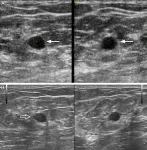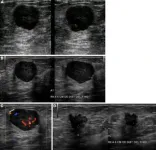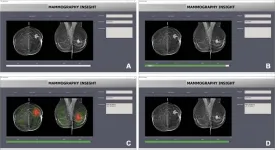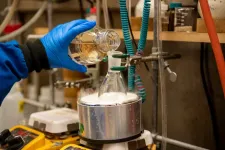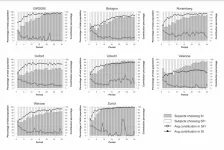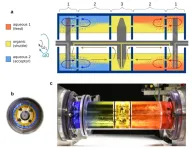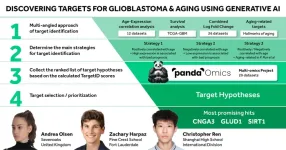(Press-News.org) OAK BROOK, Ill. – Artificial intelligence (AI) can analyze breast mass images from low-cost portable ultrasound machines and accurately identify cancer, according to a study published in Radiology, a journal of the Radiological Society of North America (RSNA). This could prove useful for triage in low-resource settings.
Breast lumps are often found accidentally, during breast self-exam or during a breast exam by a medical professional. Breast cancer screening can find cancers in the breast before the lump can be felt.
While cancer screening has been the focus in Western countries, low- and middle-income countries often lack access to organized screening programs and technology.
In low- and middle-income countries, breast cancer most commonly presents as a palpable lump in the breast. Ultrasound can play a critical role in early detection, resulting in more effective, less invasive treatment and improved outcomes.
“Women in low- and middle-income countries often cannot access breast health care for many months, even when they feel a lump in their breast that may be cancer,” said the study’s lead author Wendie A. Berg, M.D., Ph.D., professor of radiology at the University of Pittsburgh School of Medicine in Pittsburgh, Pennsylvania. “Our study looked at using AI to evaluate breast ultrasound images to distinguish suspicious breast masses needing urgent attention from those that were not cancer.”
For the multicenter study, participants with at least one palpable breast lump were enrolled in Jalisco, Mexico, from December 2017 through May 2021. Ultrasound images were obtained first with portable ultrasound at the site of the lump and adjacent tissue. Women were then imaged with standard-of-care ultrasound. Breast Imaging-Reporting and Data System (BI-RADS) assessments were performed by a radiologist.
After exclusions, 758 masses in 300 women (mean age 50.0 years) were analyzed by the AI software as benign, probably benign, suspicious or malignant (cancerous). The mean patient age was 50.0 years (range 18-92), and the mean largest lesion diameter was 13 mm (range 2-54). Of 758 masses, 360 (47.5%) were palpable, and 56 (7.4%) malignant.
AI correctly identified 96% and 98% of the women with cancer on the low-cost portable ultrasound and standard-of-care ultrasound images, respectively. Of the benign masses, 67% could have been appropriately triaged with standard-of-care ultrasound, and 38% with portable ultrasound.
Although specificity was less than with standard-of-care equipment, AI applied to portable breast ultrasound can potentially reduce about half of specialized hospital referrals in resource-limited regions.
Dr. Berg noted that the researchers did not train AI on images from the portable ultrasound. She also said that low-cost portable ultrasound technology has improved since the study was conducted. With better images and AI training, the researchers expect even better results in the future.
“Our results show great promise for the use of AI and portable ultrasound in low-resource settings, including remote/underserved areas in the United States, to help improve breast health care,” Dr. Berg said. “In reducing the number of women with benign lumps who need to be seen in central facilities and potentially have a biopsy, health care resources can be better focused on women with cancer and reduce delays in diagnosis. This should improve access, health equity and outcomes for women.”
###
“Toward AI-supported US Triage of Women with Palpable Breast Lumps in a Low-Resource Setting.” Collaborating with Dr. Berg were Ana-Lilia López Aldrete, M.D., Ajit Jairaj, B.S., Juan Carlos Ledesma Parea, M.D., Claudia Yolanda Garcia, M.D., R. Chad McClennan, M.B.A., Steven Yong Cen, Ph.D., Linda H. Larsen, M.D., M. Teresa Soler de Lara, M.S., and Susan Love, M.D.
In 2023, Radiology is celebrating its 100th anniversary with 12 centennial issues, highlighting Radiology’s legacy of publishing exceptional and practical science to improve patient care.
Radiology is edited by Linda Moy, M.D., New York University, New York, N.Y., and owned and published by the Radiological Society of North America, Inc. (https://pubs.rsna.org/journal/radiology)
RSNA is an association of radiologists, radiation oncologists, medical physicists and related scientists promoting excellence in patient care and health care delivery through education, research and technologic innovation. The Society is based in Oak Brook, Illinois. (RSNA.org)
For patient-friendly information on breast imaging, visit RadiologyInfo.org.
END
OAK BROOK, Ill. – Incorrect advice by an AI-based decision support system could seriously impair the performance of radiologists at every level of expertise when reading mammograms, according to a new study published in Radiology, a journal of the Radiological Society of North America (RSNA).
Often touted as a “second set of eyes” for radiologists, AI-based mammographic support systems are one of the most promising applications for AI in radiology. As the technology expands, there are concerns that it may make radiologists susceptible to automation bias—the tendency of humans ...
An AI model has been developed to automatically translate Akkadian text written in cuneiform into English. Hundreds of thousands of clay tablets from ancient Mesopotamia, written in cuneiform and dating back as far as 3,400 BCE, have been found by archeologists, far more than could easily be translated by the limited number of experts who can read them. Shai Gordin and colleagues present a new machine learning model that can automatically translate Akkadian cuneiform into English. Two versions of the model were trained. One version translates the Akkadian from representations of the cuneiform signs in Latin ...
A popular explanation for climate denialism is that humans will adopt beliefs that accord with their political orientation, using their cognitive abilities to explain away identity-inconsistent information in a process called “motivated reasoning.” To test this hypothesis, Bence Bago and colleagues challenged volunteers’ ability to think rationally using time pressure and cognitive loads of varying intensity. The team recruited American participants from Lucid, a website that connects academics with online survey participant pools. The authors found that people who had the ability to deliberate free of cognitive load or time ...
SAN ANTONIO – May 2, 2023 - Southwest Research Institute (SwRI) and The University of Texas at San Antonio (UTSA) have developed a method to synthesize the highly potent antimalarial drug artemisinin, which could lead to a more cost-effective treatment for malaria. The work, recently featured on the cover of the scientific journal Organic Letters, was supported by the Bill and Melinda Gates Foundation as well as a grant from the Connecting through Research Partnerships (Connect) program, a joint effort by SwRI and UTSA to enhance scientific collaboration between the two institutions.
In 2021, 247 million cases of malaria led to 619,000 deaths worldwide. The most effective ...
The American Society for Biochemistry and Molecular Biology sent recommendations to the National Institutes of Health on April 14 to improve working conditions for postdocs.
The society recommended that the NIH:
Ensure a livable wage, benefits, etc. for postdocs
Require that principle investigators help postdocs craft a training plan
Require that principal investigators complete mentor training programs
Expand programs to create more academic staff scientist positions
Collect data on postdoc career outcomes
“Many of our members who run labs are struggling to recruit and retain qualified postdocs,” Sarina Neote, public affairs director ...
A multi-lab replication of a 2006 study supports the role of peer sanction in promoting human cooperation. Cooperation is imperative for society to successfully solve complex problems, including climate change. One approach many groups have adopted is a system of peer sanctions for noncooperators. Such a system incurs costs to participants, who must impose the sanctions, but can allow cooperators to feel more secure that their investments in the shared project will be matched by others. A 2006 study suggested that groups with peer sanctions outgrew and outperformed groups without a peer-sanctioning institution. In light ...
In a world that is slowly distancing itself from carbon-based energy, there has been a meteoric rise in the use of lithium-ion batteries as a next-generation energy storage solution. However, this has resulted in another problem - an increase in the amount of lithium battery waste. Lithium-ion batteries degrade slowly over their lifetime, losing anywhere from 12% to 24% of their total capacity over 500 charging and discharging cycles. The electrolyte and other materials inside the battery can also degrade, causing a decrease in capacity over time. The disposal of lithium batteries ...
WASHINGTON, D.C. – The Patient-Centered Outcomes Research Institute (PCORI) today began inviting proposals for new studies and implementation projects through nine funding opportunities. These PCORI Funding Announcements (PFAs) include four offering up to $452 million for comparative clinical effectiveness research (CER) studies comparing health care approaches to help patients and their caregivers make better-informed health choices given their particular circumstances. Additional PFAs offer funding for a range of projects that support and advance patient-centered CER and use of PCORI-funded research results.
“With ...
New York, NY (May 2, 2023)—Applying machine learning models, a type of artificial intelligence (AI), to data collected passively from wearable devices can identify a patient’s degree of resilience and well-being, according to investigators at the Icahn School of Medicine at Mount Sinai in New York.
The findings, reported in the May 2nd issue of JAMIA Open, support wearable devices, such as the Apple Watch®, as a way to monitor and assess psychological states remotely without requiring the completion of mental health questionnaires.
The ...
Three high school students – Andrea Olsen from Oslo, Norway; Zachary Harpaz from Boca Raton, Florida; and Chris Ren from Shanghai, China – co-authored a paper using a generative artificial intelligence (AI) engine for target discovery from Insilico Medicine (“Insilico”) called PandaOmics to identify new therapeutic targets for glioblastoma multiforme (GBM). GBM is the most aggressive and common malignant brain tumor, accounting for 16% of all primary brain tumors. The findings were published on April 26 in the journal Aging.
Olsen, a student at Sevenoaks School in Kent, UK, began interning at Insilico Medicine in 2021, after discovering ...
